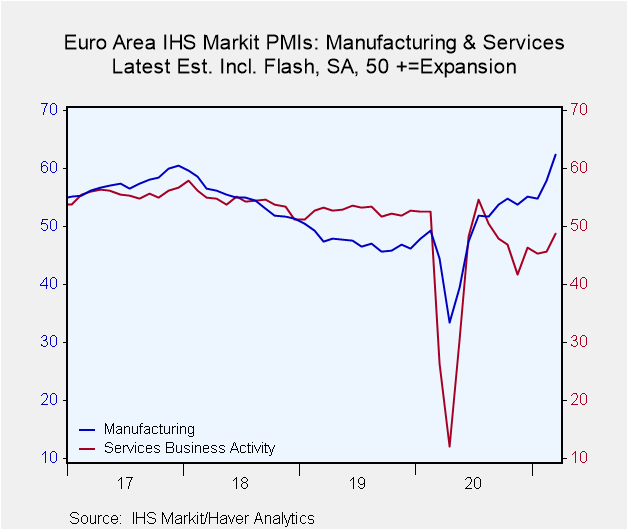 Global| Mar 24 2021
Global| Mar 24 2021Europe's composite PMI Moves Strongly Higher-Shows Expansion Again
Summary
The Markit PMI 'flash' readings for March show improvement and for the most part - strong improvement - all up and down the line. Japan is the sole exception with a small improvement month-to-month based on small improvements in both [...]
 The Markit PMI 'flash' readings for March show improvement and for the most part - strong improvement - all up and down the line. Japan is the sole exception with a small improvement month-to-month based on small improvements in both manufacturing and services. But Japan also does log an improvement.
The Markit PMI 'flash' readings for March show improvement and for the most part - strong improvement - all up and down the line. Japan is the sole exception with a small improvement month-to-month based on small improvements in both manufacturing and services. But Japan also does log an improvement.
Of the six entities that report out flash data in the table, four have service sectors that rank in the lower 25 percentile of their queue of outcomes since December 2016. Of these, France and Japan also have very weak composite readings that are themselves in the lower 25 percentiles of their queue of values since December 2016. The EMU has a strong enough manufacturing reading to drive its composite rating barely above its 50th percentile. Germany alone manages to have a very weak service sector and still logs a strong composite reading with a standing in its 80th percentile.
Manufacturing is uniformly strong among these participants with only Japan an exception. The manufacturing PMIs show no country with a standing below its 96th percentile except for Japan's 50th percentile standing. Clearly the PMIs are chronicling a strong manufacturing presence
Germany and the United States and have very strong PMI readings in manufacturing for the last three months with manufacturing PMI values above 55 for the last five months or more. U.S. manufacturing has been strong since November; in Germany the period of exceptional strength goes back to September.
However, the international service sector's condition is generally far worse than for manufacturing. Japan, France and the EU report out services PMIs that are below 50 indicating contraction. Germany reports a service sector at 50.8 for March, just above the neutral mark. The U.S. has a service sector response at a solid 60.0 (a 98.1 percentile standing) and this is curious. We know in the U.S. many service sector firms are closed; many have gone out of business. I don't know what criteria are being applied to set these diffusion gauges, but it is hard for me to believe that the U.S. service sector (with so many of its people still out of work!) is as hot as a 60% diffusion index in services suggests. This may have to do with how the surveys deal with a company once it shuts its doors and is out of business, perhaps for good. Understandably, businesses that do not exist do not participate in the survey. But we should bear in mind that this service sector reading now applies to a much smaller sector and one that has been decimated by the virus globally. The survey may also be referring to firms that are open but operating at reduced capacity by government edict.
The chart plot above shows that manufacturing in the EMU has been gaining pace and is now off to a very serious episode of strengthening. It contrasts to the service sector where the index rebounded from the virus hit early last year but since had a relapse. The service sector does show some very recent pick up, but it is not clear if it is gathering momentum or just leveling out.
Finally, diffusion indexes are statements about the breadth of month-to-month changes. We interpret more breadth (more firms expanding) as more strength even though breadth and strength are two different concepts. Still, we can see that there is a strong correlation between strength and breadth. But we should be careful to keep in mind what PMI indexes measure and how they measure it. For now this seems to be a distinction that is more applicable to the service sector.
Robert Brusca
AuthorMore in Author Profile »Robert A. Brusca is Chief Economist of Fact and Opinion Economics, a consulting firm he founded in Manhattan. He has been an economist on Wall Street for over 25 years. He has visited central banking and large institutional clients in over 30 countries in his career as an economist. Mr. Brusca was a Divisional Research Chief at the Federal Reserve Bank of NY (Chief of the International Financial markets Division), a Fed Watcher at Irving Trust and Chief Economist at Nikko Securities International. He is widely quoted and appears in various media. Mr. Brusca holds an MA and Ph.D. in economics from Michigan State University and a BA in Economics from the University of Michigan. His research pursues his strong interests in non aligned policy economics as well as international economics. FAO Economics’ research targets investors to assist them in making better investment decisions in stocks, bonds and in a variety of international assets. The company does not manage money and has no conflicts in giving economic advice.






